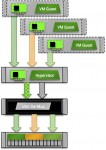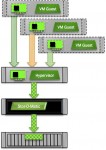I’ve talked a lot about the I/O blender in the last decade or so.[1. I’ve even been told I invented the term!] I’ve always said that information is the solution, allowing arrays to de-multiplex data. But a new enterprise storage company, Infinidat, claims that they can beat the I/O blender using math. Here’s their concept.
I/O blender
#VMEspresso with @SolarWinds at #VMworld: “Storage I/O is About to Get Crazy”
Join me for “Storage I/O is About to Get Crazy”! I’ll be speaking on Tuesday morning, August 26, at 7:30 AM at Jillian’s San Francisco, right on the corner next to Moscone and the rest of VMworld. SolarWinds is sponsoring this talk and will provide breakfast (including gourmet coffee) to any and all registered VMworld attendees.
VMware’s Hardware Partner Strategy: Heads I Win, Tales You Lose
VMware is in an enviable but tricky situation: The company must work closely with hardware partners, keeping these prime sales and promotional channels happy and supportive. But VMware must also innovate around proprietary OEMs, subverting their products with integrated software before a rival steps up with an integrated alternative.
The I/O Blender Part 3: Behold the Power of the Demultiplexer
Virtualization has disrupted the I/O path, reducing the value of enterprise storage arrays. But all is not lost: An effort is afoot to make things right by increasing communication between hypervisor and array and demultiplexing data before it is stored.
The I/O Blender Part 2: What Does Virtualization Do?
Virtualization is a disruptive technology in every sense of the word. By abstracting and simplifying physical resources, virtualization enables dynamic utilization. But this “translation†from physical to virtual disrupts the assumptions that enable performance and flexibility of physical devices such as storage arrays.




